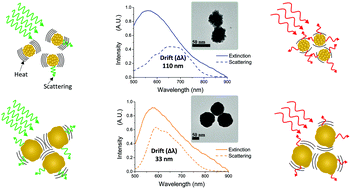Spectral drifts in surface textured Fe3O4-Au, core–shell nanoparticles enhance spectra-selective photothermal heating and scatter imaging†
Abstract
We report a significant spectral drift (up to 110 nm) between optical scattering and extinction in magnetite-gold (Fe3O4-Au) core–shell nanostructures. The drift was observed experimentally using single-particle broadband dark-field scattering microspectroscopy and solution extinction experiments. Infrared thermography demonstrates an enhanced photothermal activity of these nanoparticles at extinction wavelengths that are far drifted from the wavelengths that produce the best results for imaging via scattering. For example, a relatively smooth gold shell leads to 19% more photothermal activity at 532 nm compared to 690 nm whereas a rough-texture, popcorn type morphology gold shell with three times higher drift, is 170% more efficient at 532 nm. We suggest that the enhanced photothermal response results directly from a reduced competition between absorption and scattering as a consequence of the spectral drift. This spectral drift can be advantageous in multimodal theranostics where therapy and imaging are performed independently at different wavelengths.



 Please wait while we load your content...
Please wait while we load your content...